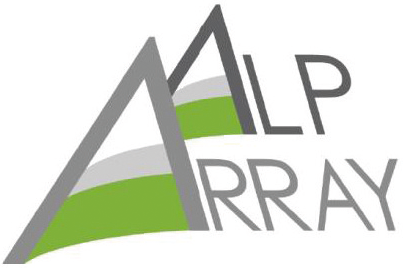Related Projects
Several large projects and/or planned initiatives interact with this SPP:
AlpArray (http://www.alparray.ethz.ch/home/) is a European initiative to advance our understanding of orogenesis and its relationship to mantle dynamics, plate reorganizations, surface processes and seismic hazard in the Alps-Apennines-Carpathians-Dinarides orogenic system. The initiative integrates present-day Earth observables with high-resolution geophysical imaging of 3D structure and physical properties of the lithosphere and of the upper mantle, with focus on a high-end seismological array.
CIFALPS “China-Italy-France Alps Seismic Survey” is a passive seismic experiment across the Western Alps (summer 2012 to April 2013) that has acquired and interpreted data along a single transect (https://isterre.fr/research-28/projets-de-recherche/projets-en-cours/autres-projets/article/projet-cifalps-china-italy-france?lang=fr). Like the swaths in MB-4D, the transect comprises closely spaced (5-10 km) stations, with several stations deployed off-section to complement the French permanent network. The results of this campaign are of first-order interest to participants of MB-4D, including geological colleagues working at the surface above the purported slab rupture in the Western Alps (Theme 2). Several colleagues involved in CIFALPS are members of the AlpArray consortium (Prof. Dr. A. Paul, Univ. Grenoble).
EARTHSHAPE “Earth Surface Shaping by Biota” is a DFG Priority Program (SPP-1803) since 2014 to explore the role of biological processes in soil-production and topography-formation, specifically in the Andean (Chilean) coastal ranges (https://esdynamics.geo.uni-tuebingen.de/earthshape/index.php?id=129). Although the focus is decidedly biotic and the Andes differ from the Alps both climatically and tectonically (and presumably also biotically), Earthshape adds a potentially useful dimension to future attempts to model the dynamics of surface processes in Theme 2. Two initiators of Earthshape are also members of this SPP (T. Ehlers, F. von Blanckenburg).
EPOS“European Plate Observing System”, is the integrated solid Earth Sciences research infrastructure approved by the European Strategy Forum on Research Infrastructures (ESFRI) and included in the ESFRI Roadmap. EPOS is a long-term plan for the integration of existing national research infrastructures in seismology (http://www.epos-eu.org/). AlpArray and, with it this SPP, demonstrate the viability of the EPOS concept.
GAIN “Geodetic Alpine Integrated Network” is an international network of more than 35 permanent GPS stations that are part of the ALPS-GPSQUAKENET network to monitor surface hazards in the Alpine domain (http://www.alpine-space.org/2000-2006/alps-gpsquakenet.html). The German component of this network, co-managed by the DGFI and TU-München, comprises stations along the northern perimeter of the Eastern Alps. Together with other networks (EUREF, FreDNet, etc.), there are more than 100 operational GPS stations in the Alpine region. Through co-operation with Prof. Dr. Florian Seitz, a participant in this SPP, expertise from this network is integrated (Themes 2, 4).
GEOMOLis an EU-funded project (2012-2015) to assess subsurface potential of the Alpine foreland (Molasse) basins for sustainable planning and use of natural resources (http://www.geomol.eu/home/index_html). This project emphasizes 3D modeling of basin architecture as related to water management, geothermal energy, C02 sequestration and hydrocarbon exploration. The subsurface images of the foreland basins from GEOMOL are of potential interest to all research themes and activities in this SPP because sedimentary basins are important geo-archives for recording the history of motion and denudation (Themes 2, 4).
Geosystem – The Changing Earth (2014-2018) of the Helmholtz-Gemeinschaft monitors coupled processes at the regional scale in the following locations: the North Anatolian transform plate boundary, the Central Asian plate collisional zone, the South African passive margin, the Dead Sea transform system and the Chilean convergent plate boundary (http://www.gfz-potsdam.de/en/research/topics/geosystem-the-changing-earth/). The central Asian and Chilean components are thematic complements to the AlpArray experiment (Theme 4). Know-how from these observatories are relevant to the deployment and data-handling tasks of this SPP.
Oceans – From the Deep Sea to the Atmosphere (2014-2018) of the Helmholtz-Gemeinschaft applies novel techniques to increase the resolution and coverage of the seafloor and ocean margins to aid our understanding of the dynamic processes in the ocean basins, particularly as they affect society. One of the focus themes will be crustal configuration and earthquake potential along the Eurasian-African plate boundary. This complements the research themes outlined in this SPP, even though the latter are focused on continental collisional and the Alpine domain. The obvious synergies and links between these programs, e.g., in the quantification of tectonically active deformation zones and resulting potential hazards will be exploited.
TOPO-Europe has provided a network for multidisciplinary, international projects focussing on links between deep Earth geodynamics and surface or near-surface processes that contribute to Earth’s topography (http://www.esf.org/). The network has included large geophysical experiments (TOPO-IBERIA, 2008-2012), European-funded training networks (TOPO-MOD, 2010-2013)(SUBITOP, 2016-2019) and a large EUROCORE program (2009-2013). Many of the scientific objectives of MB-4D complement TOPO-Europe, and PIs from MB-4D and AlpArray have participated in past TOPO-Europe projects.
ZIP – “Zooming in between Plates – deciphering the nature of the plate interface in subduction zones” is an EC post-graduate training program (2013-2017) devoted to earthquake-related processes along subduction zone megathrusts (http://www.zip-itn.eu). The emphasis is on micro- to meso-scale processes (fluid-rock interaction, strain localization) in fossil subduction channels, a field with cross-fertilization with Theme 3 in this SPP.
Alps and Peripheral Basins is a French research program (RGF/BGRM) that runs from 2020 - 2021 funding PhD and Master studies with relation to the AlpArray program. A list of projects can be found on the RGF website as well as in this list including some general information (last updated January 2021).


